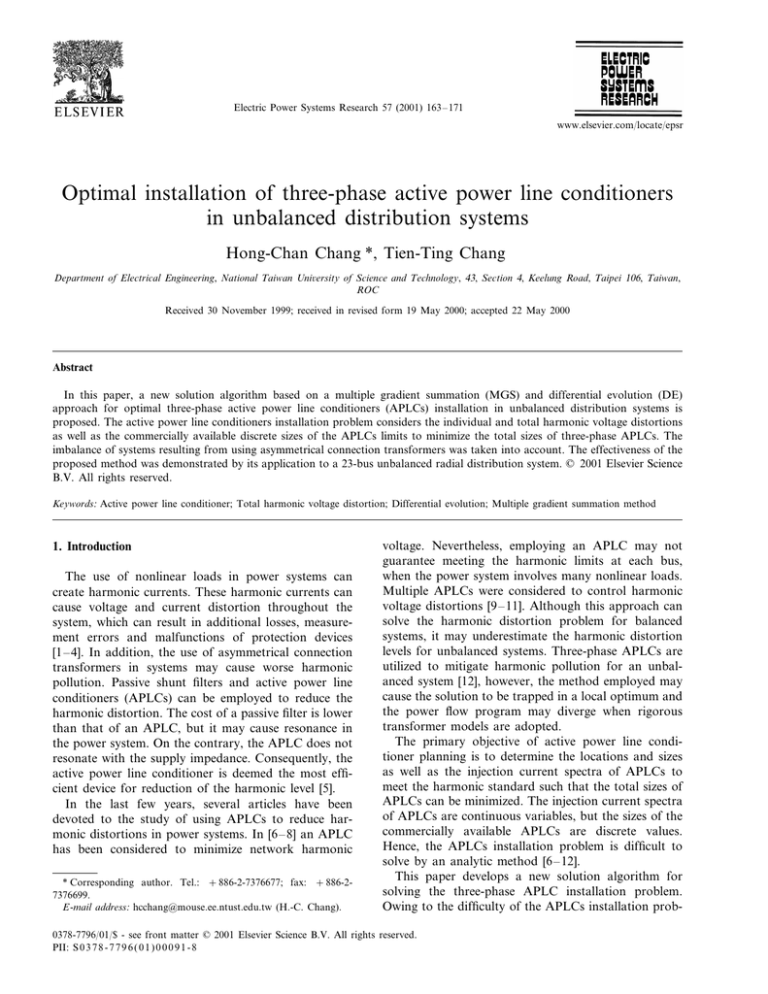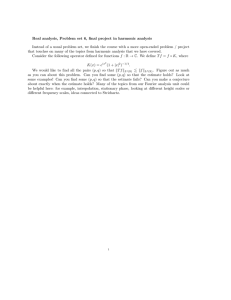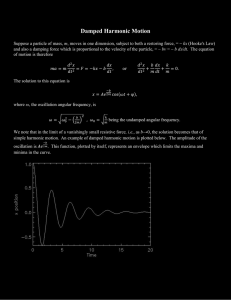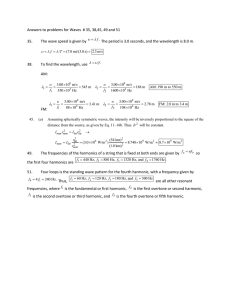
Electric Power Systems Research 57 (2001) 163– 171
www.elsevier.com/locate/epsr
Optimal installation of three-phase active power line conditioners
in unbalanced distribution systems
Hong-Chan Chang *, Tien-Ting Chang
Department of Electrical Engineering, National Taiwan Uni6ersity of Science and Technology, 43, Section 4, Keelung Road, Taipei 106, Taiwan,
ROC
Received 30 November 1999; received in revised form 19 May 2000; accepted 22 May 2000
Abstract
In this paper, a new solution algorithm based on a multiple gradient summation (MGS) and differential evolution (DE)
approach for optimal three-phase active power line conditioners (APLCs) installation in unbalanced distribution systems is
proposed. The active power line conditioners installation problem considers the individual and total harmonic voltage distortions
as well as the commercially available discrete sizes of the APLCs limits to minimize the total sizes of three-phase APLCs. The
imbalance of systems resulting from using asymmetrical connection transformers was taken into account. The effectiveness of the
proposed method was demonstrated by its application to a 23-bus unbalanced radial distribution system. © 2001 Elsevier Science
B.V. All rights reserved.
Keywords: Active power line conditioner; Total harmonic voltage distortion; Differential evolution; Multiple gradient summation method
1. Introduction
The use of nonlinear loads in power systems can
create harmonic currents. These harmonic currents can
cause voltage and current distortion throughout the
system, which can result in additional losses, measurement errors and malfunctions of protection devices
[1 – 4]. In addition, the use of asymmetrical connection
transformers in systems may cause worse harmonic
pollution. Passive shunt filters and active power line
conditioners (APLCs) can be employed to reduce the
harmonic distortion. The cost of a passive filter is lower
than that of an APLC, but it may cause resonance in
the power system. On the contrary, the APLC does not
resonate with the supply impedance. Consequently, the
active power line conditioner is deemed the most efficient device for reduction of the harmonic level [5].
In the last few years, several articles have been
devoted to the study of using APLCs to reduce harmonic distortions in power systems. In [6 – 8] an APLC
has been considered to minimize network harmonic
* Corresponding author. Tel.: + 886-2-7376677; fax: +886-27376699.
E-mail address: hcchang@mouse.ee.ntust.edu.tw (H.-C. Chang).
voltage. Nevertheless, employing an APLC may not
guarantee meeting the harmonic limits at each bus,
when the power system involves many nonlinear loads.
Multiple APLCs were considered to control harmonic
voltage distortions [9–11]. Although this approach can
solve the harmonic distortion problem for balanced
systems, it may underestimate the harmonic distortion
levels for unbalanced systems. Three-phase APLCs are
utilized to mitigate harmonic pollution for an unbalanced system [12], however, the method employed may
cause the solution to be trapped in a local optimum and
the power flow program may diverge when rigorous
transformer models are adopted.
The primary objective of active power line conditioner planning is to determine the locations and sizes
as well as the injection current spectra of APLCs to
meet the harmonic standard such that the total sizes of
APLCs can be minimized. The injection current spectra
of APLCs are continuous variables, but the sizes of the
commercially available APLCs are discrete values.
Hence, the APLCs installation problem is difficult to
solve by an analytic method [6–12].
This paper develops a new solution algorithm for
solving the three-phase APLC installation problem.
Owing to the difficulty of the APLCs installation prob-
0378-7796/01/$ - see front matter © 2001 Elsevier Science B.V. All rights reserved.
PII: S 0 3 7 8 - 7 7 9 6 ( 0 1 ) 0 0 0 9 1 - 8
H.-C. Chang, T.-T. Chang / Electric Power Systems Research 57 (2001) 163–171
164
lem, we solve it in two stages in the proposed approach.
First, the constraint on discrete sizes of APLCs was
released, and the multiple gradient summation method
(MGS) [14] was employed to solve the resulting continuous nonlinear programming sub-problem. Secondly,
the differential evolution method (DE) was employed
to account for discrete sizes of APLCs, and to further
improve the solution quality. Due to the capability to
deal with the continuous nonlinear programming problem, the MGS is employed to find high quality approximate solutions, which will be used as parts of the initial
vector population for the DE. DE is a new stochastic
and parallel search method with ability to handle nondifferential and nonlinear functions. It converges faster
and with more certainty than many other global optimization methods [15]. In view of this, the DE method
was adopted to quickly find the optimal solution. Making use of the advantages of both MGS and the DE
method, the proposed approach was shown to be effective for the APLC installation problem. To consider the
imbalance caused by using asymmetrical connection
transformers, and improve the power flow program
convergence, integrated models of distribution transformers and their loads were used [13].
bus is within the limit, and VTHDmax is usually 5%. Eq.
(4) denotes that the sizes of APLCs are discrete in
nature.
the set of harmonic orders, it has nh elements
the set of bus installations of the APLCs, it
has nf elements
{Ib, 2Ib, …, mIb}
the base unit size of the APLC
the maximum size of the APLC
the total number of the system bus
the real part of the APLC current of phase p
at bus k for harmonic h
the imaginary part of the APLC current of
phase p at bus k for harmonic h
the rms current of the APLC of phase p at
bus k
the harmonic voltage of phase p at bus i for
harmonic h
the fundamental frequency voltage of phase p
at bus i
Sh
Sf
Ssize
Ib
mIb
nb
I h,r
k,p
I h,i
k,p
Ik,p
V hi,p
V li,p
The harmonic voltage of phase p at bus i for harmonic h can be written as:
2. Description of problem
V hi,p = % z hik,pI hk,p + V hio,p,
The APLC installation problem considered in this
paper is to determine the locations, sizes and injection
current spectra of three-phase APLCs. The objective is
to minimize the total sizes of the APLCs while satisfying the harmonic voltage distortion limits. Furthermore, the commercially available discrete sizes of
APLCs and the imbalance caused by the use of asymmetrical connection transformers should be accounted
for. The APLC installation problem can be expressed
as follows:
Min F = %
%
2
h,i 2
% (I h,r
k,p) +(I k,p)
(1)
p = a,b,c k Sf h Sh
subject to:
V hi,p/V li,p5V hmax
'
% V h 2
i,p
h Sh
,
(2)
V 5 VTHDmax
l
i,p
p = a, b, c
Ik,p =
n
2
h,i 2
% (I h,r
k,p) + (I k,p)
h Sh
1/2
i= 1, …, nb;
(3)
Ssize
k Sf;
where,
z hik,p =
I hk,p =
V hio,p =
z hik,p
R hik,p
X hik,p
V hio,p
V h,r
io,p
V h,i
io,p
h Sh, p = a, b, c
i= 1, …, nb;
Constraint Eq. (2) ensures that the individual harmonic voltage distortion for each bus is within the
limit, and V hmax is usually 3%. Constraint Eq. (3) ensures that the total harmonic voltage distortion for each
R hik,p+jX hik,p
h,i
I h,r
k,p+jI k,p
h,r
V io,p+jV h,i
io,p
the ikth element of the bus impedance of
phase p for harmonic h
the real part of z hik,p
the imaginary part of z hik,p
the harmonic voltage of phase p at bus i
for the original system
the real part of V hio,p
the imaginary part of V hio,p
Substituting Eq. (5) into Eqs. (2) and (3), respectively,
we obtain:
)
)
G hi,p = % z hik,pI hk,p + V hio,p 5 0.03V li,p
k Sf
p =a, b, c.
(4)
(5)
k Sr
i= 1, …, nb;
h Sh, p=a, b, c
H ti,p =
! )
%
(6)
)"
% z hik,pI hk,p + V hio,p
h Sh k Sf
i= 1, …, nb, p=a, b, c.
2 1/2
5 0.05V li,p
(7)



